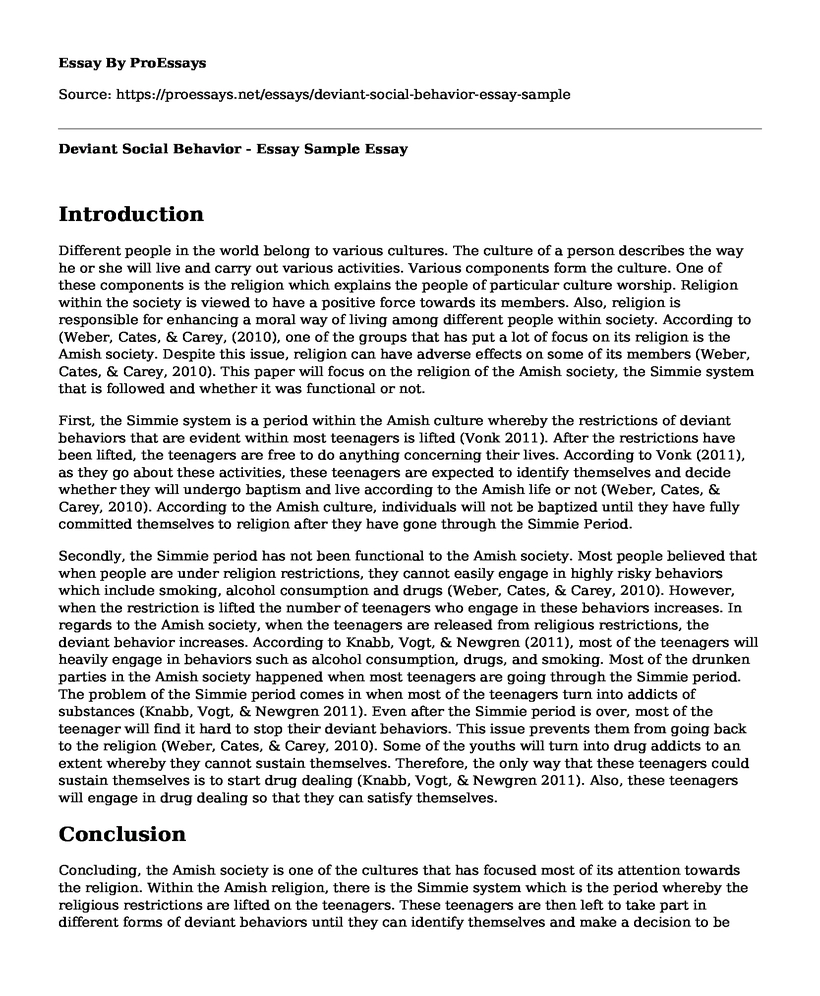Introduction
Different people in the world belong to various cultures. The culture of a person describes the way he or she will live and carry out various activities. Various components form the culture. One of these components is the religion which explains the people of particular culture worship. Religion within the society is viewed to have a positive force towards its members. Also, religion is responsible for enhancing a moral way of living among different people within society. According to (Weber, Cates, & Carey, (2010), one of the groups that has put a lot of focus on its religion is the Amish society. Despite this issue, religion can have adverse effects on some of its members (Weber, Cates, & Carey, 2010). This paper will focus on the religion of the Amish society, the Simmie system that is followed and whether it was functional or not.
First, the Simmie system is a period within the Amish culture whereby the restrictions of deviant behaviors that are evident within most teenagers is lifted (Vonk 2011). After the restrictions have been lifted, the teenagers are free to do anything concerning their lives. According to Vonk (2011), as they go about these activities, these teenagers are expected to identify themselves and decide whether they will undergo baptism and live according to the Amish life or not (Weber, Cates, & Carey, 2010). According to the Amish culture, individuals will not be baptized until they have fully committed themselves to religion after they have gone through the Simmie Period.
Secondly, the Simmie period has not been functional to the Amish society. Most people believed that when people are under religion restrictions, they cannot easily engage in highly risky behaviors which include smoking, alcohol consumption and drugs (Weber, Cates, & Carey, 2010). However, when the restriction is lifted the number of teenagers who engage in these behaviors increases. In regards to the Amish society, when the teenagers are released from religious restrictions, the deviant behavior increases. According to Knabb, Vogt, & Newgren (2011), most of the teenagers will heavily engage in behaviors such as alcohol consumption, drugs, and smoking. Most of the drunken parties in the Amish society happened when most teenagers are going through the Simmie period. The problem of the Simmie period comes in when most of the teenagers turn into addicts of substances (Knabb, Vogt, & Newgren 2011). Even after the Simmie period is over, most of the teenager will find it hard to stop their deviant behaviors. This issue prevents them from going back to the religion (Weber, Cates, & Carey, 2010). Some of the youths will turn into drug addicts to an extent whereby they cannot sustain themselves. Therefore, the only way that these teenagers could sustain themselves is to start drug dealing (Knabb, Vogt, & Newgren 2011). Also, these teenagers will engage in drug dealing so that they can satisfy themselves.
Conclusion
Concluding, the Amish society is one of the cultures that has focused most of its attention towards the religion. Within the Amish religion, there is the Simmie system which is the period whereby the religious restrictions are lifted on the teenagers. These teenagers are then left to take part in different forms of deviant behaviors until they can identify themselves and make a decision to be baptized so that they can be considered members of the religion. The Simmie period has not been functioning to the Amish community because some teenagers become addicted to the deviant behaviors. These teenagers begin consuming hard drugs and alcohol during the Simmie period, and later they become addicts. In other cases, the teenagers will continue to engage in deviant behaviors because they get some satisfaction from it.
References
Knabb, J. J., Vogt, R. G., & Newgren, K. P. (2011). MMPI-2 characteristics of the Old OrderAmish: A comparison of clinical, nonclinical, and United States normative samples.Psychological assessment, 23(4), 865.
Vonk, M. A. (2011). Sustainability and quality of life: Religious worldviews, values andenvironmental impact of Amish, Hutterite, Franciscan and Benedictine communities.
Weber, C., Cates, J. A., & Carey, S. (2010). A drug and alcohol intervention with Amish youth:Dancing on the devil's playground. Journal of Groups in Addiction & Recovery, 5(2), 97-112.
Cite this page
Deviant Social Behavior - Essay Sample. (2022, Nov 19). Retrieved from https://proessays.net/essays/deviant-social-behavior-essay-sample
If you are the original author of this essay and no longer wish to have it published on the ProEssays website, please click below to request its removal:
- Research Paper on Impact of Different Parenting Styles
- Parent's Guide to the Admission, Review, and Dismissal Process Paper Example
- Get Out: Analysis of Interracial Relationship and Family Dynamics
- Essay Example on Moral Dilemma of War: Deontology vs Utilitarianism
- Essay Example on Delinquency Trends Among Teenagers: Anomie & Subculture Theories
- Essay Example on Exploring Canadian and Indigenous Families: Intersectional Analysis
- Essay Example on Black Americans: A History of Oppression and Resistance







